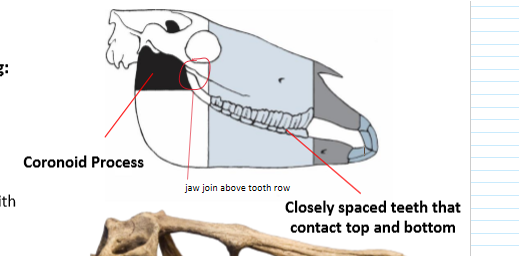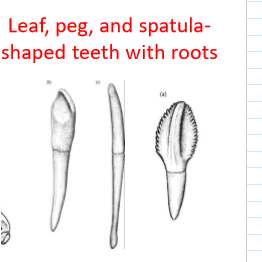9 - dinosaur eating ability
1/12
There's no tags or description
Looks like no tags are added yet.
Name | Mastery | Learn | Test | Matching | Spaced |
|---|
No study sessions yet.
13 Terms
reptilian chewing
Snakes
Teeth that hook backwards
Only used for holding not showing
Prey is swallowed whole
Rattlesnakes
Fangs are mostly just used to inject venom
Komodo Dragons
Pointy teeth angled backwards to grab and RIP flesh into smaller pieces
Spaced out so things don't get stuck in between
Not used for chewing
Can open jaw really wide to seize, kill, dismember prey
Joint is at the same level as the lower tooth row
Does not allow the jaw to move from side to side
Good for holding on to prey
Jaw works like a scissor
Slices from back to front
But does not allow for chewing because the teeth do not all contact at once
herbivore chewing
Skull divided into 3 parts
Cropping section
Teeth shaped like blades to bite off food
Diastema
Gap used for food manipulation
Cheek teeth
AKa molars
Food is ground into a paste
Adaptations that allow for chewing
Coronoid process bone expands for jaw muscle attachment
Teeth closely packed together with flat grinding surfaces
Teeth occlusion
Inset tooth row that supports cheeks
jaw joint is above the tooth row
All of the upper and lower teeth contact at the same time
Less stable but allows for grinding from side to side
Hypothetically a jaw joint below could also function the same way

chewers v. non-chewer
Non chewers
Usually carnivores
Rarely herbivores
chewers
Herbivore's and omnivores
carnivores
Do not chew their food
Larger pieces of meat can easily be digested by stomach acid
Characteristics
Simple, single chambered stomach
Short digestive tracks
Slim torsos that are V shaped or tapered
herbivores
Plants are harder to digest so need to be chewed
Digestive enzyme in saliva that helps breakdown carbohydrates
Large, barrel shaped guts for long digestive tracks needed to breakdown plant matter
Enable symbiotic relationship between herbivore and bacteria
gastroliths
Small stones to mechanically processed food for those who do not chew
Becomes round overtime
Some animals retain them others passed them and need to replace them
Also used as a weight in many aquatic animals
ex. Birds, crocodiles, alligators, seals, sea lions
principle of uniformitarianism
found in modern world so can assume existed in dinosaurs too
chewing ability of theropods
Spaced out teeth or areas where there's no teeth
Tooth row is not inset
Wide gape
Pointy serrated teeth
Main tooth function is tearing things apart
Slim torso
jaw joint is at the to throw so the jaw worked like scissors
How do they deal with prey?
Some were able to hold onto their prey
For prey smaller than them
others had the slashing bite tactic
Biting then releasing to wait for the animal to bleed out
For prey larger than them
chewing ability of sauropodomorphs
jaw joint is below the tooth row but still bad chewers
Spaced out teeth
Tooth row is not inset
Tooth shape
Leaf, Spatula, Peg shaped
So few grinding surfaces
Main tooth function is to puncture vegetation
Barrel shaped cuts for fermentation
Evidence for gastroliths

chewing ability of ornithischians
Skull is similar to mammals
Cropping section
Cropping is done with the beak aka rhamphotheca
Made of keratin which does not preserve in fossils
diastema
cheek teeth
jaw Joint is below the tooth row
Some groups were better than others
direct evidence of what they ate
Coprolite aka poop
Can see bones, plants, crab legs
Cololites
Gut contents like seeds
Rare because they're soft material that does not fossilize well
indirect evidenc eof what they ate
Find all the fossils in an area
Generalization
The carnivores probably ate the herbivores and the herbivores ate plants
Finding teeth marks on bones
Comparative anatomy
comparative anatomy
Fish eaters
ex. Crocodiles
Long narrow snout
Can whip head from side to side to catch fish
Cone shaped teeth that interlock with each other
To trap slippery prey
Forward tilting teeth
Procumbent teeth to spear fish
Birds
Will have a sharp pointed beak the spear fish or large lower jaw to scoop them out of the water
Plant eaters
ex. Koala
Incisors at the front of the mouth are chisel shaped
To grasp at trees
diastema between incisors and large cheek teeth (molars) that have broad grinding surfaces
Molars shred into smaller pieces
Can store food in the cheek pouch
Jaw joints above tooth row
Less sheer but allows side to side motion
Inset Teeth rows
Insect eaters
ex. Anteaters
No teeth
Narrow long jaw
Long tongue with hooks
Shape of mouth allows it to flick in and out quickly and efficiently
Can reach up to two feet beyond the end of its snout
Covered in tiny barbs and thick sticky saliva so that it can collect as many insects as possible
Strong claws to break open mounds
Carnivores
ex. hawk
No teeth
Hooked beak
To tear meat apart
Sharp talons
To kill
ex. of what diff. dinosaurs ate
Allosaurus
Ancestor of T Rex
carnivore
Parasaurolophus
Offset jaw
Beak and diastema
Probably a good chewer
Shuvuuia
Long jaw
Probably ate insects
Spinosaurus
Big separated teeth that are curved
Probably ate fish